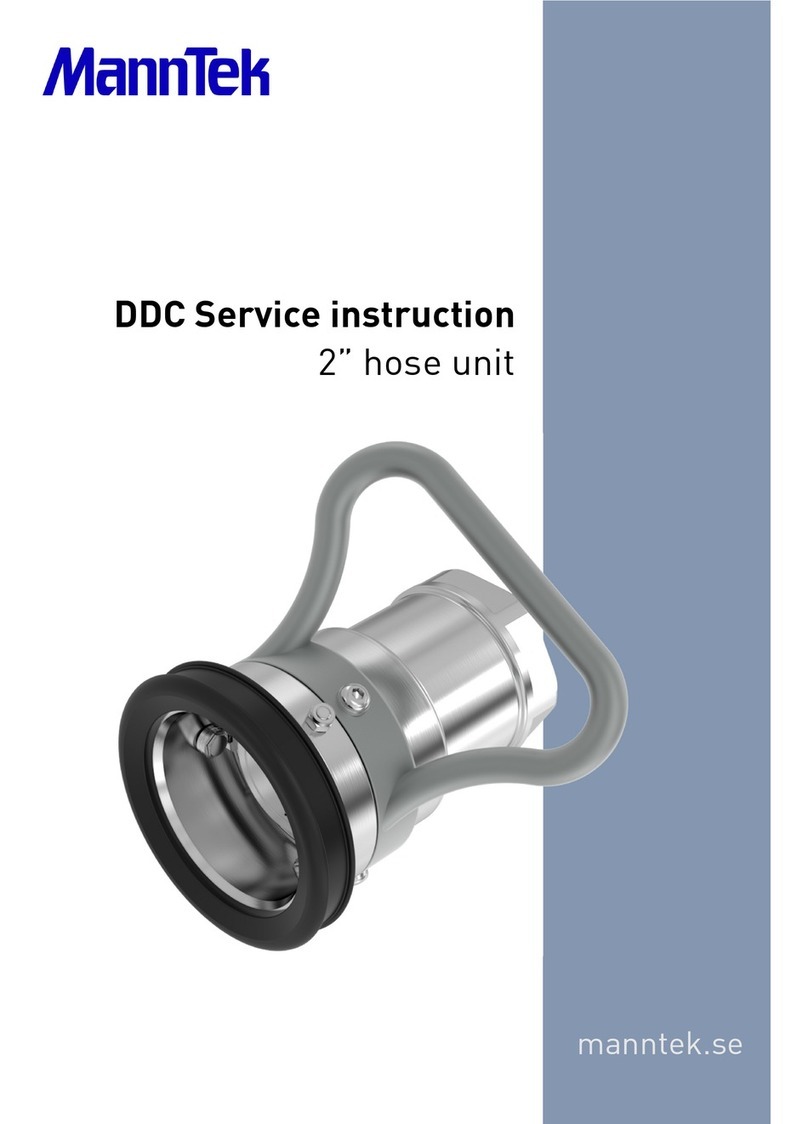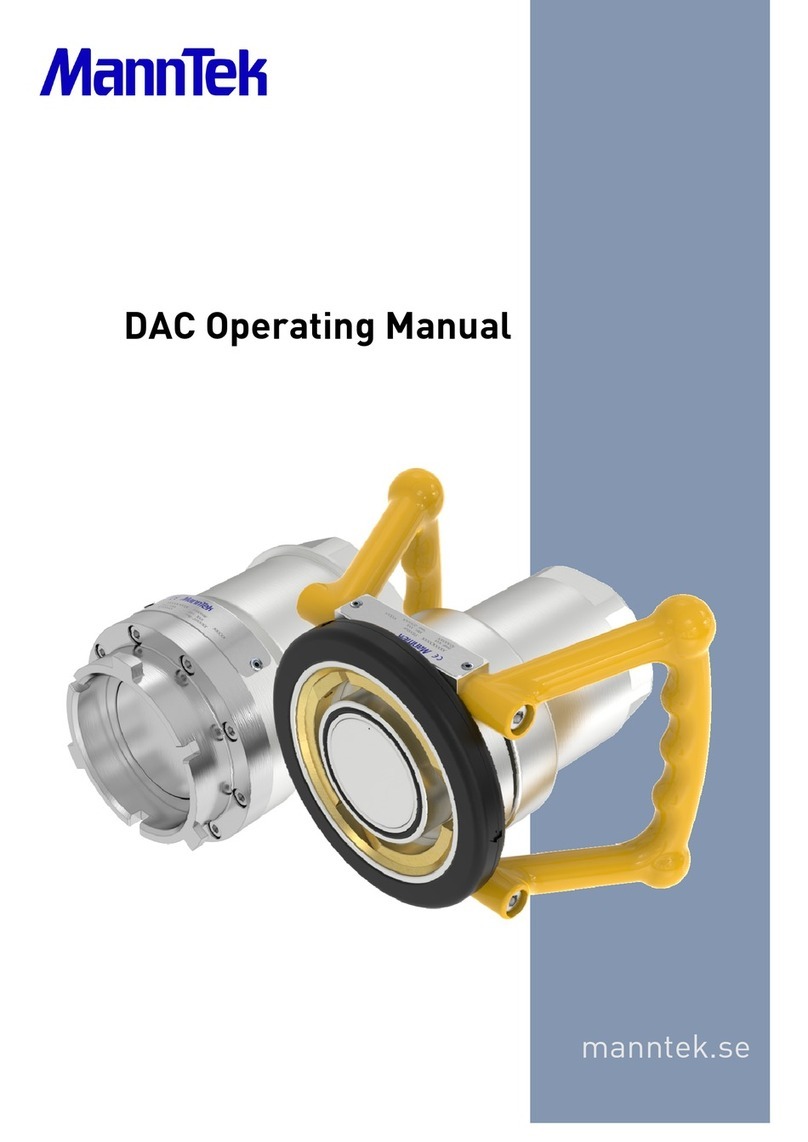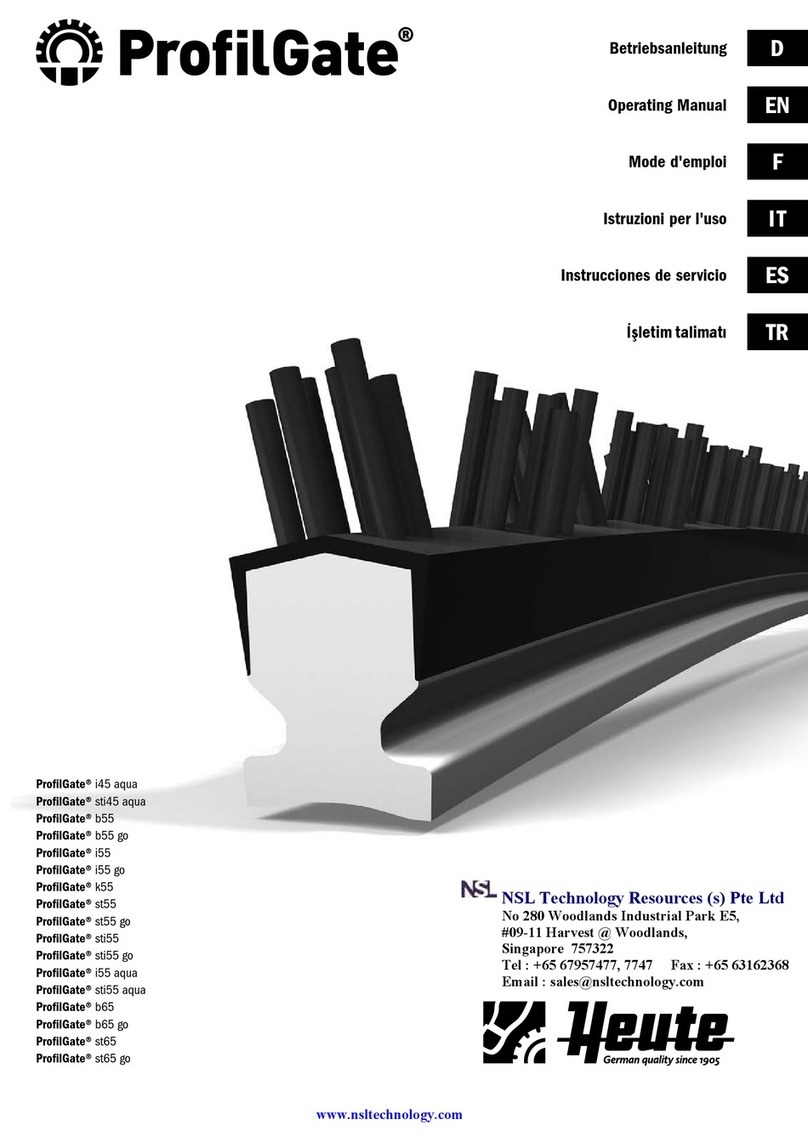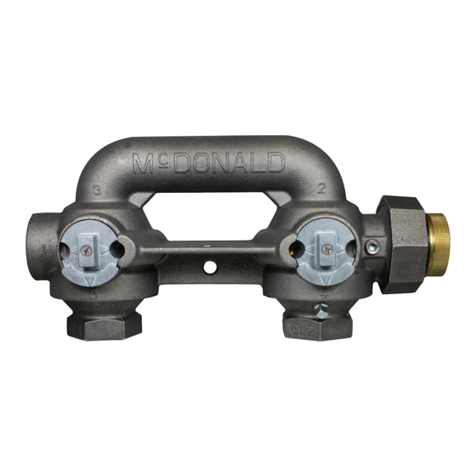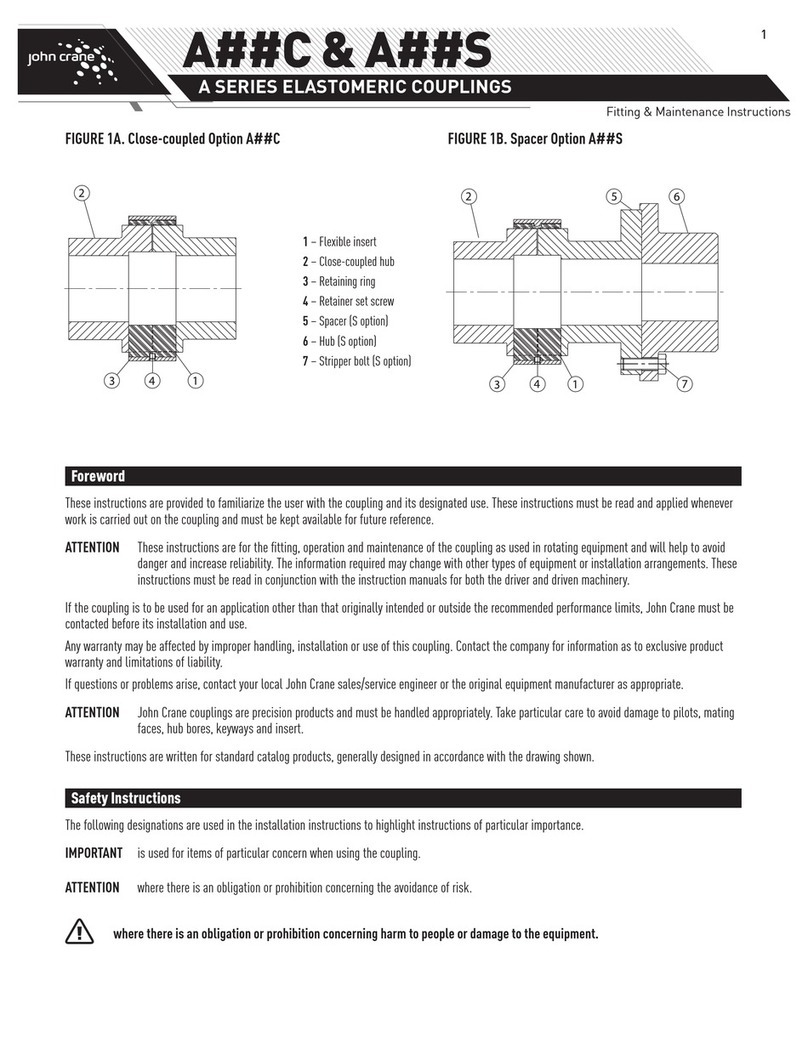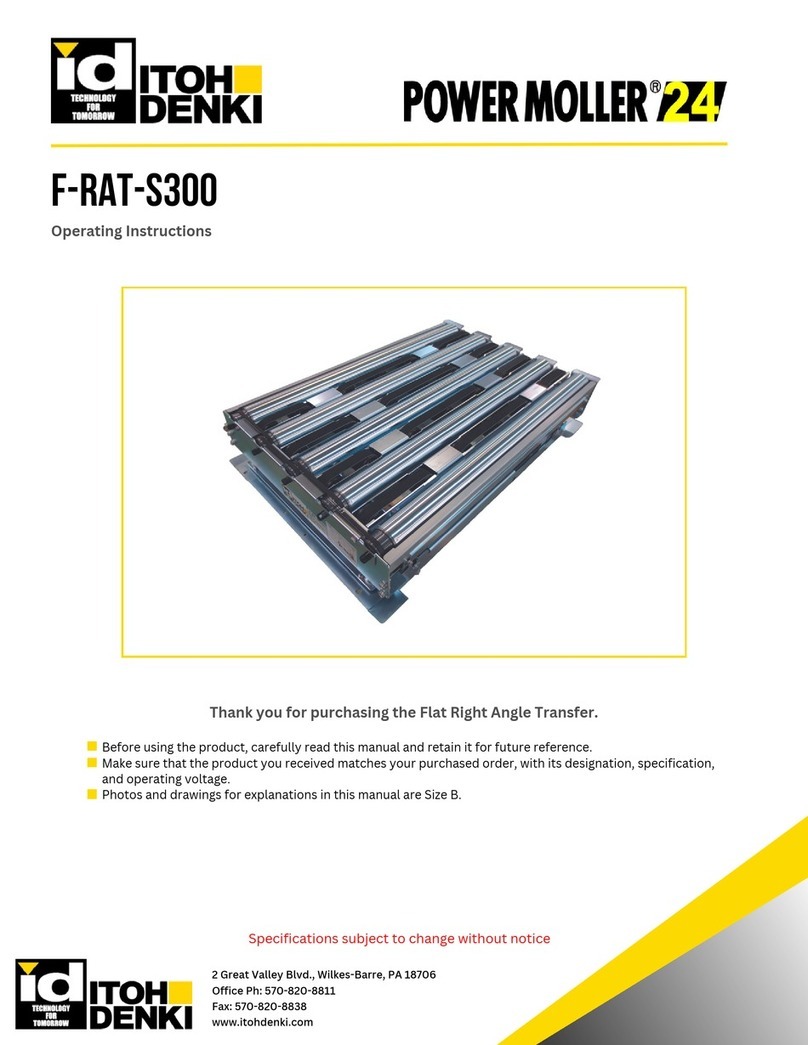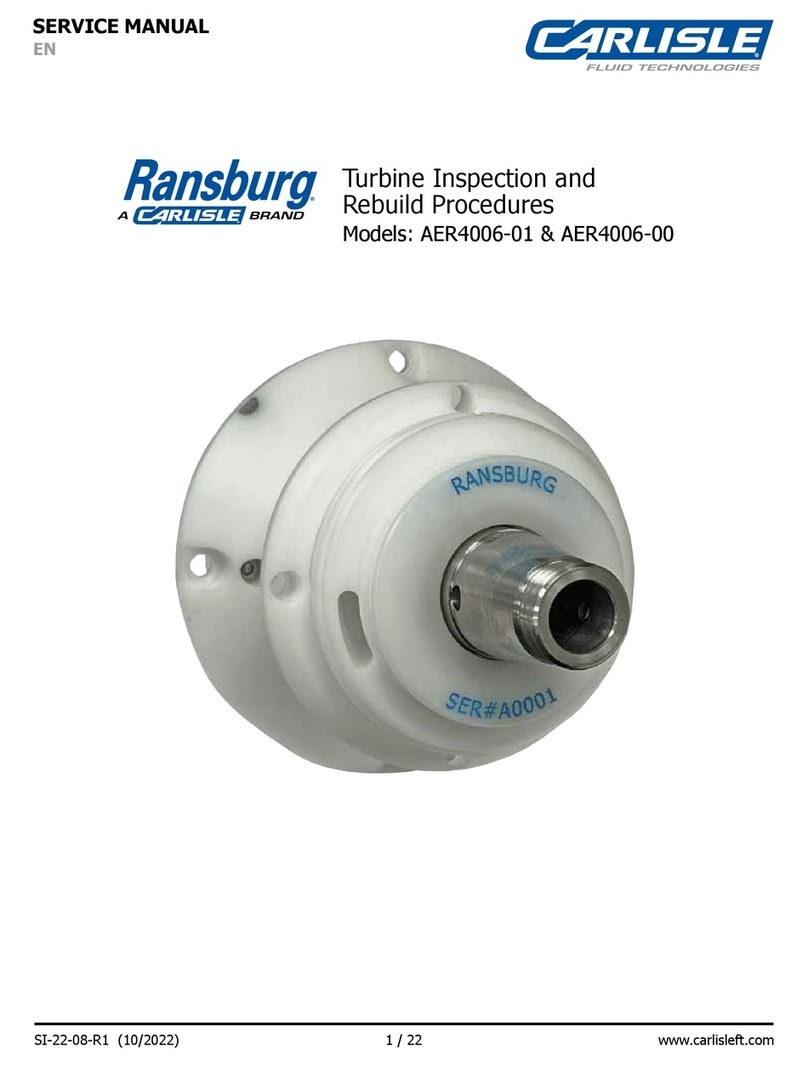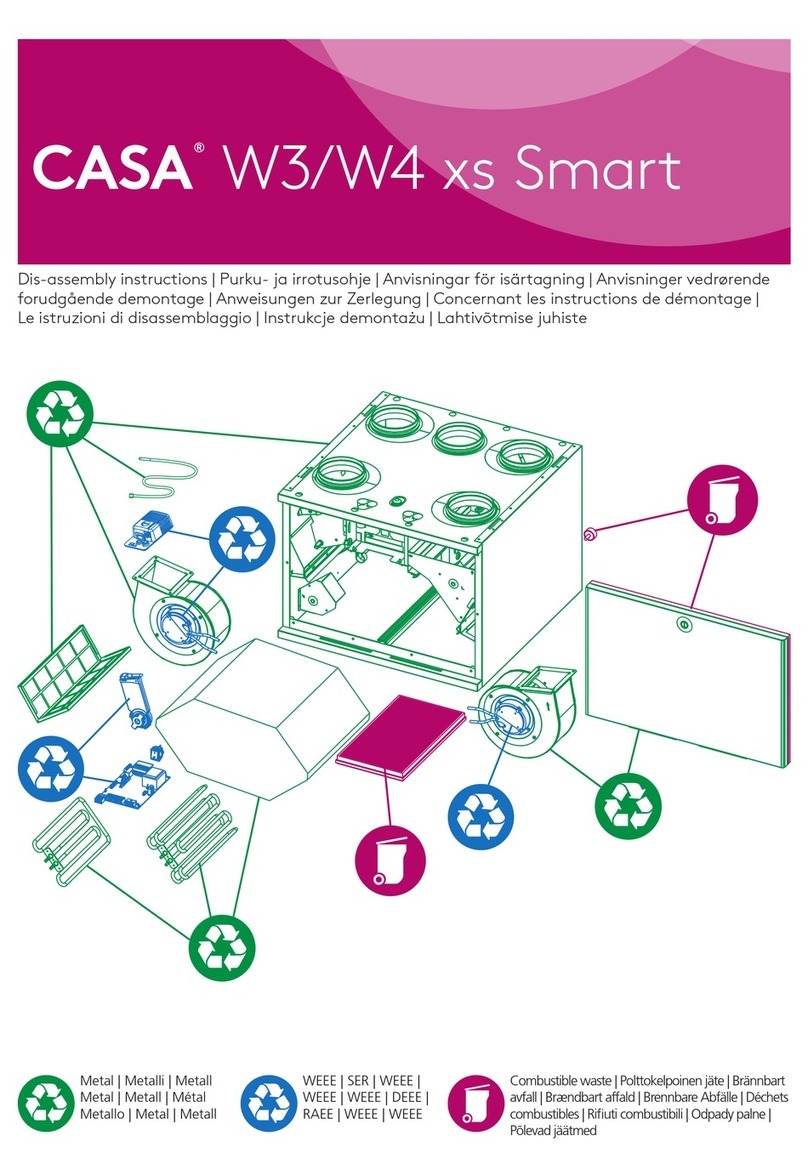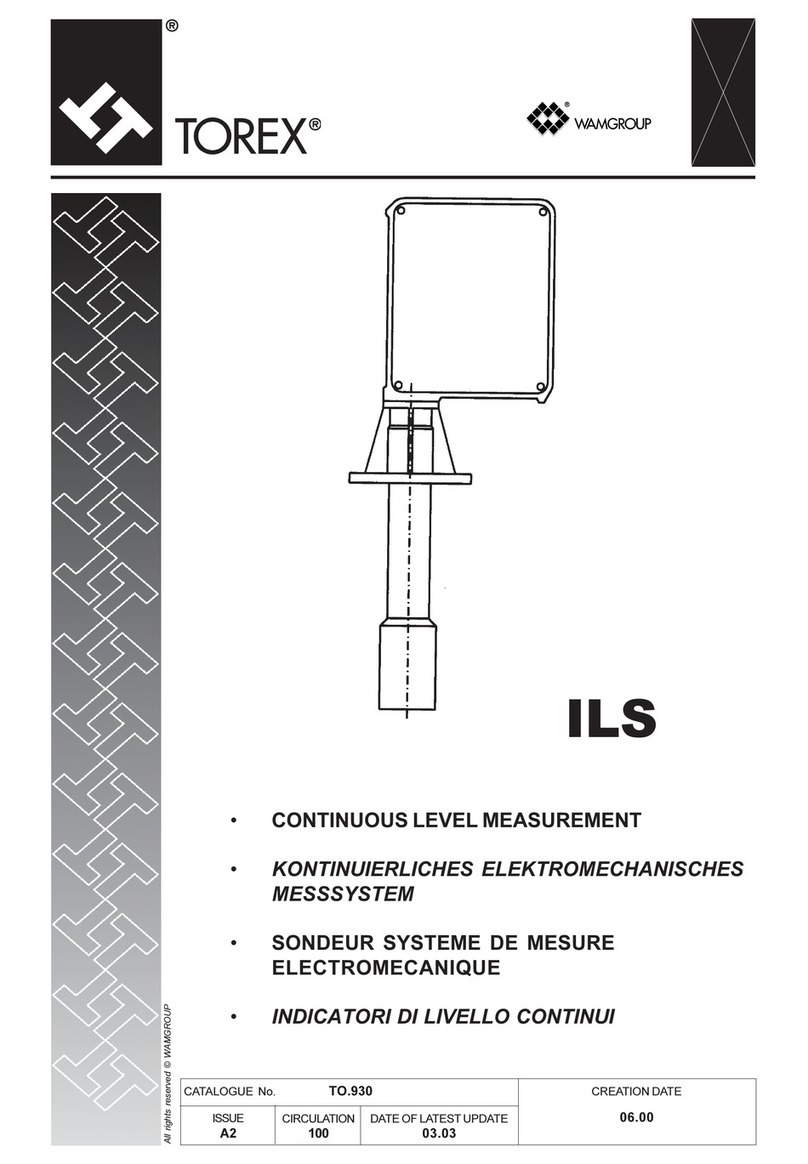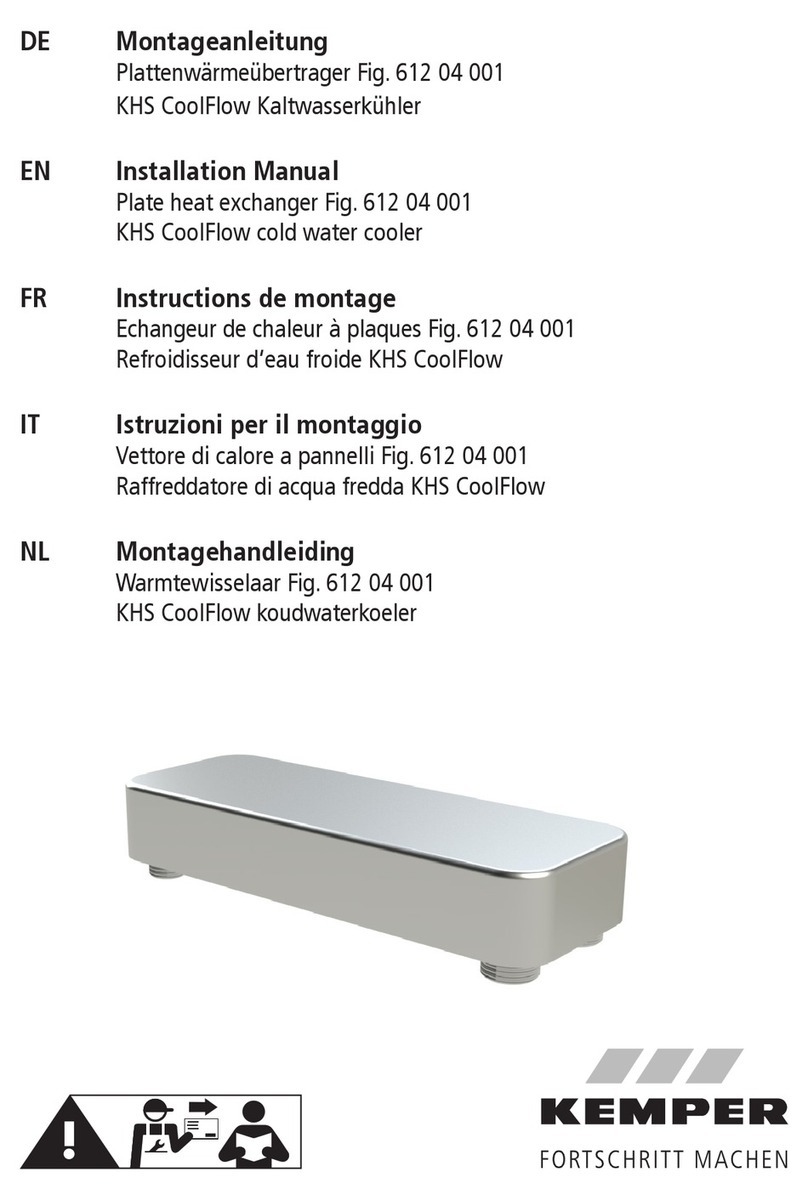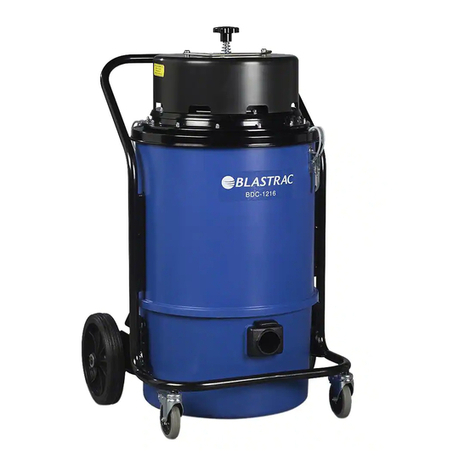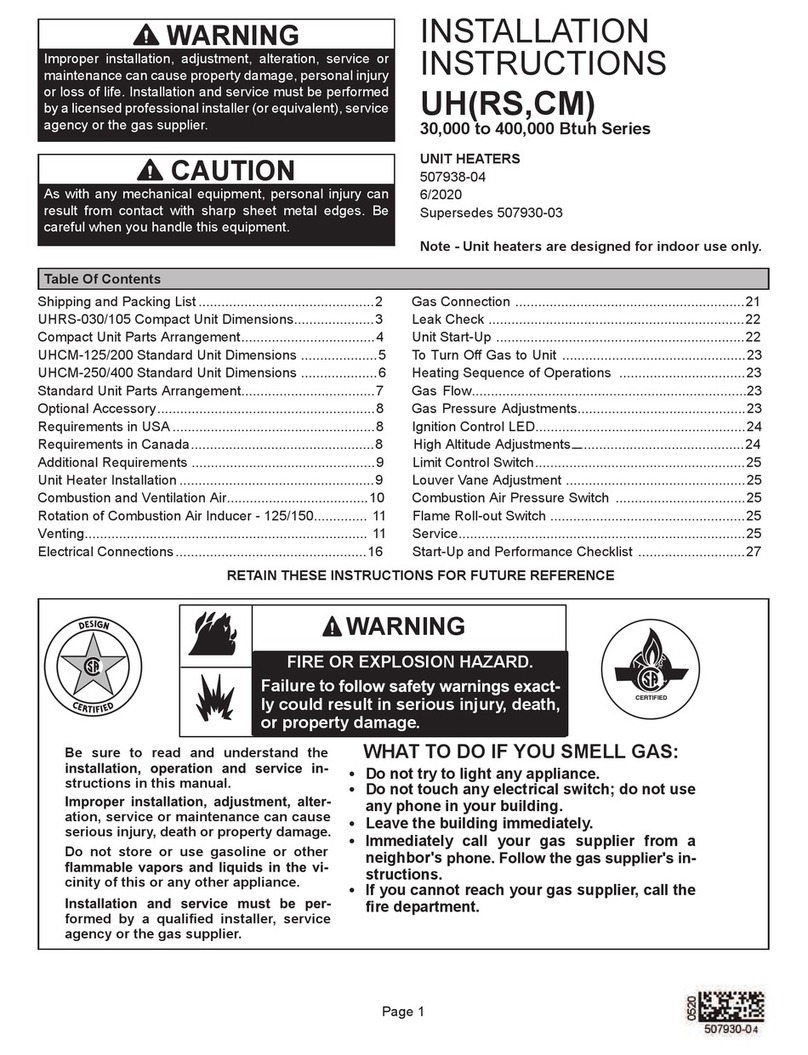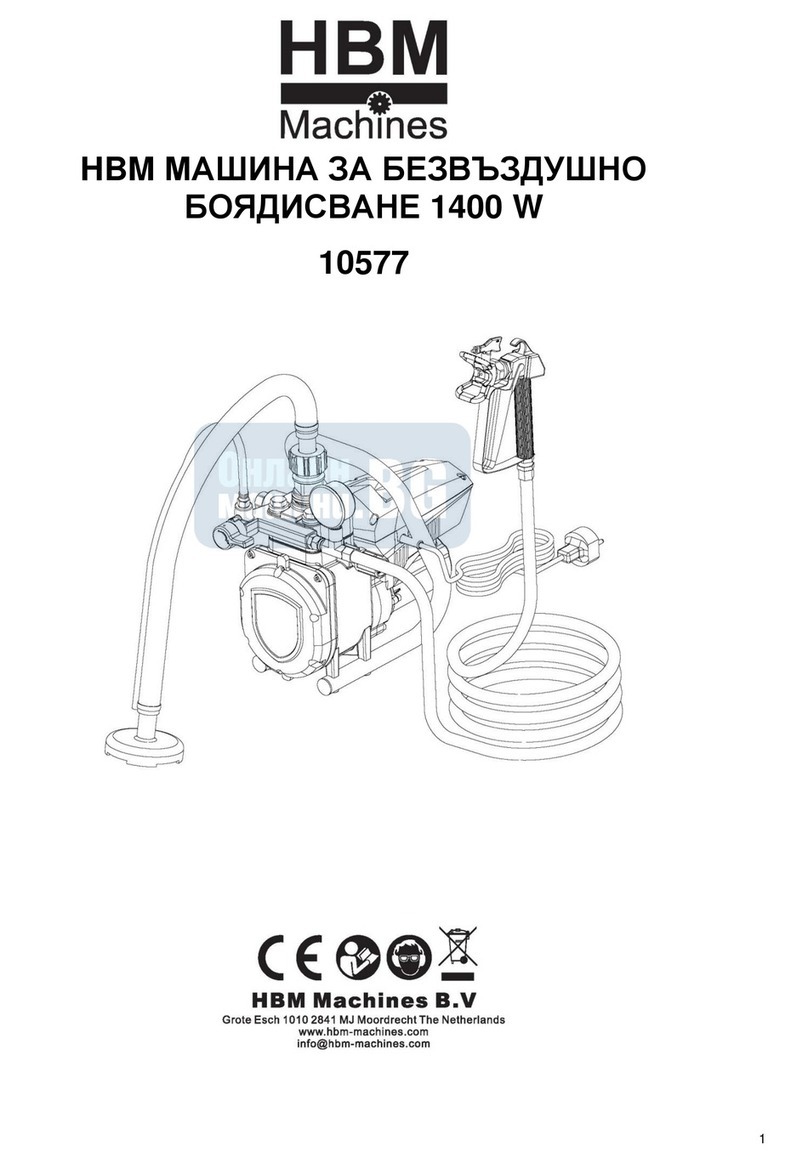Manntek SBC User manual

manntek.se
SBC Operating Manual
1" ‑ 6"

2
2018-10-31
Foreword
This operating manual applies to the persons using the Safety Breakaway Couplings.
It is very important to read and understand this operation manual before use of this
coupling. Become familiar with the unit’s operation, applications and limitations. Be
particularly aware of its specic hazards. Store this manual in a clean area and always at
a readily available location. Additional copies at no charge can be obtained through written
requests.
IMPORTANT!!
READ THE COMPLETE DOCUMENTATION
The base for this manual follows the EU-Directives:
Pressure Equipment Directive 2014/68/EU of 15 May 2014
Potentially Explosion Atmosphere Directive 2014/34/EU of 29 March 2014
• Do not make modications that are not authorized by the manufacturer.
• Read and respect all warnings and instructions provided to you.
• Use only original MannTek spare parts for maintenance.
SUMMARY OF REVISIONS
Date of change Description
2015-05-21 1. Edition
2018-10-09 General review & New layout, Updated EU-Directives
2018-10-31 2. Edition - devided in two sizes

3
2018-10-31
Table oF ConTenT
Foreword 2
1 Introduction 4
1.1 Intended use 4
1.2 Product specication 5
1.3 Technical data 5
1.4 Breaking pins 6
1.5 Identication plate e.g. for SBC 2½”- 2½" BSP 7
1.6 Scope of delivery 7
2 General safety rules 8
2.1 Safety instructions 8
3 Transport and storage 10
3.1 Delivery check 10
3.2 Complaints/return of goods 10
3.3 Returning used product 10
3.4 Sample of certicate of decontamination 11
3.5 Storage 11
4 Installation 12
4.1 Initial operation 12
4.2 Installation 12
5 Operation 15
5.1 General notes 15
5.2 Daily visual inspection 15
5.3 Cleaning 15
5.4 Disassembly 15
5.5 Improper use 15
5.6 Maintenance/repair 15
5.7 Miscellaneous 16
6 Maintenance and repair 17
6.1 General information 17
6.2 Maintenance and service instruction 18
6.3 Spare parts and tools 18
6.4 Assembly 19
6.5 Pressure and tightness test 22
7 Applicable documents 23
7.1 Declaration of conformity 23

4
2018-10-31
1 InTroduCTIon
1.1 InTended use
The Safety Breakaway Coupling (SBC) acts as a safety component in the supply line of
mobile refuelling systems, preventing damage to the environment whenever the supply
hose or pipe bursts during lling or emptying due to a change in location of the tank.
The coupling valves on the tank and on the supply line immediately close whenever the
housing halves Breakaway.
All MannTek products are designed for trouble free
operation in a wide range of applications and operating
conditions. Reliable and safe operation is dependent
upon the correct installation and handling of the
equipment. Regular and appropriate maintenance
is essential to ensure both safety and reliability over
the life of the equipment. Take care that the product
is only used inside the limits of the following product
specication.
There are two kinds of SBCs available. A marine type version is designed for offshore
applications. The specic design requires an installation between two hoses. It is only
possible to release the coupling by axial force.
The length of the hose segments should not
be less than L=a/57,3 x (r+d/2).
L = min. required hose length
a = max. bending angle
r = min. bending radius
d = outer hose diameter
Figure 1: min. required hose length depending
on bending angle shown for hoses according
to EN12115
The second SBC type is an industrial version. Regularly it is connected to a tank or a x
connection point inside a loading station on one side and a hose or a loading arm on the
other side. This makes that the SBC can be released under a pull force angle up to 90º.

5
2018-10-31
1.2 ProduCT sPeCIFICaTIon
Product name: Safety Breakaway Coupling
Sizes: 1", 2", 2½", 3", 4", 5" and 6"
Thread Connection: NPT-Thread ANSI B1.20.1, BSP-Thread ISO 228
Flange Connection: Flange EN 1092, ANSI B16.5, DIN 28459, T.T.M.A., BS 10
Other Connection: MIL-C-10387J, DIN 11850, DIN 11864, DIN 32676, ISO 2852
Material (casting): EN 10213 – 1.4408/1.4409+AT
ASTM A351 – CF-3M or CF-8M EN 1982 – CC491K
EN 1706 – AC-42000/42100-T6
Material (machined): EN 10272 – 1.4401/1.4404+AT
ASTM A479 – S31603 (316L) EN 12164 – CW614N
EN 755-2 – EN AC-5083 or AC-6026/6262-T6
Working pressure: 10 bar / 16 bar / 25 bar / 150 psi / 360 psi
Max test pressure: 16 bar / 25 bar / 40 bar / 240 psi / 540 psi
Temperature range: -20ºC to + 80ºC -Outside this range, between
-54ºC and + 250ºC ask for conrmation
1.3 TeChnICal daTa
Table 1: Nominal Widths, Weight and Dimensions [mm]
Nominal width Breaking Force Connection KG (Stainless steel) D (mm) L (mm)
DN25 - 1" 3,2 kN 1" Thread 1,7 74 126
1" Flange 4,2 115 132
DN50 - 2" 13 kN 2" Thread 2,6 114 178
2" Flange 7,3 165 178
DN65 - 2½" 22 kN 2½" Thread 7,4 140 251
2½" Flange 13,2 191 214
DN80 - 3" 33 kN 3" Thread 8,5 174 279
3" Flange 15,1 210 222
DN100 - 4" 52 kN 4" Thread 15,5 211 320
4" Flange 20,7 254 239
DN125 - 5" 81 kN 5" NPT male 32 269 362
5" Victaulic 31 269 341
DN150 - 6" 92 kN 6" Thread 46,8 304 400
6" Flange 57,6 318 384

6
2018-10-31
Table 2: Materials
Component Material no. Standard Operating
temperature
Housing Check
valve
1.4404 EN 10270-1.4401+AT -54°C to 250° C
1.4409 EN 10213-1.4409+AT
CW614N EN 12164-CW614N -54°C to 200° C
CB491K EN 1982.CB491K-GS
5083 EN 755- AW-5083
-54°C to 100° C
6262 EN 755- AW 6262-T6
42100 EN 1706-AC-42100-T6
Spring 1.44.1 EN10270-1.4401 -54°C to 250° C
Table 3: Seals
Component Material Standard2Operating temperature1
O-ring
NBR Perbunan TM , Buna N -38° C to 80° C
EPDM Buna AP -54° C to 120° C
FFKM Kalrez TM , Chemraz TM -15° C to 260° C
FKM Viton TM -20° C to 200° C
1.4 breakIng PIns
Mann Teknik AB delivers breaking pins according to customer specication. Standard
pins are available for different applications. The breaking force should be specied for the
weakest component
Without any specication we supply our couplings with bolts according to the following
table.
Table 4: Internal pressure reduces the force needed to release the coupling.
Breakin
Force at DN25 DN50 DN65 DN80 DN100 DN125 DN150
0 bar
6 bar -0,7 kN -1,1 kN -2,6 kN -3,8 kN -5,7 kN -7,9 kN -11,1 kN
10 bar -1,1 kN -1,9 kN -4,4 kN -6,3 kN -9,5 kN -13,2 kN -18,6 kN
16 bar -1,9 kN -3,1 kN -7,0 kN -10,1 kN -15,2 kN -21,2 kN -29,8 kN
25 bar -2,9 kN -4,9 kN -11,0 kN -15,9 kN -23,7 kN -33,1 kN -46,5 kN
37,5 bar -4,4 kN -7,3 kN -16,5 kN -23,8 kN -35,6 kN -49,7 kN -69,8 kN
40 bar -4,8 kN -7,8 kN -17,6 kN -25,4 kN -38,0 kN -53,0 kN -74,5 kN
150 psi -1,2 kN -2,0 kN -4,5 kN -6,5 kN -9,8 kN -13,7 kN -19,2 kN
300 psi -2,4 kN -4,0 kN -9,1 kN -13,1 kN -196 kN -27,4 kN -38,5 kN
1For temperature stability of the seal material used must be considered separately for each individual case
2 Kalrez, Viton = Registered Trademarks of DuPont; Chemraz = Registered Trademark of Green Tweed

7
2018-10-31
Our standard specication was made for LPG hoses with a minimum burst pressure at
100 bar. For other applications you can specify the breaking force depending on the burst
pressure of your hose.
Table 5: Recommended breaking force for different hose burst pressures:
Burst pressure hose DN25 DN50 DN65 DN80 DN100 DN125 DN150
30 bar 4 kN 7 kN 11 kN 18 kN 28 kN 40 kN
40 bar 6 kN 10 kN 15 kN 24 kN 37 kN 54 kN
48 bar 7 kN 12 kN 18 kN 28 kN 45 kN 65 kN
60 bar 3,0 kN 9 kN 15 kN 23 kN 36 kN 56 kN 81 kN
68 bar 3,2 kN 92 kN
80 bar 12 kN 20 kN 30 kN 48 kN 75 kN 108 kN
100bar 4,8 kN 13 kN 22 kN 33 kN 52 kN 81 kN 117 kN
600 psi 6 kN 10 kN 15 kN 24 kN 39 kN 56 kN
1200 psi 3,1 kN 12 kN 21 kN 31 kN 49 kN 78 kN 112 kN
Table 6: Max. spill under disconnection at max working pressure:
Nominal diameter DN25 DN50 DN65 DN80 DN100 DN125 DN150
Max. spill at WP 0,05 l 0,1 l 0,2 l 0,4 l 0,6 l 1,2 l 2,0 l
1.5 IdenTIFICaTIon PlaTe e.g. For sbC 2½”- 2½" bsP
Industrial Type Marine Type
Article no: N312D4401A* N312M4401A*
Working Pressure PS: 25 bar 25 bar
Max Test Pressure PT: 30 bar 30 bar
Breaking Force BF: 22 kN 22 kN
Seal: FPM (Viton) FPM (Viton)
Mtrl: Stainless Steel Stainless Steel
Size: DN65 – 2½“ DN65 – 2½"
*For key of article no. please ask for explanation list.
1.6 sCoPe oF delIvery
1 pcs N312D4401A Safety Breakaway Coupling
In case of ange connection gaskets and bolts to mount the coupling into the application is
not part of the delivery. For NPT thread use PTFE tape for sealing (see chapter 4.2).

8
2018-10-31
2 general saFeTy rules
Before you install any MannTek equipment it is essential to check that the material and
performance specications are acceptable for your specic application. The pressure
ratings and primary materials of the construction are clearly indicated on the identication
plate of each MannTek product. A drawing showing the materials of construction relating
to each individual component is available upon request. The technical department at
MannTeknik AB is always happy to provide guidance on material suitability. Our data
is taken from published chemical resistance information as well as our own application
experiences. Specication checks should always be carried out before the product is
supplied, but if unsure, ask! Especially if you are using the products outside the specied
temperature range, ask for conrmation regarding your application.
Do not assume that a MannTek product supplied for one specic application
automatically will be suitable for other similar applications. Many variables
affect the performance of materials. If you wish to use a MannTek product for a
different application than the one originally specied, check with Mann Teknik
AB to ensure compatibility before installation. Please remember, the application
details should include all media transferred through the coupling. Not just the
primary transferred media. As with all equipment, a check should be made
to ensure that the installation fulls the requirements of applicable prevailing
industry, local, national and international standards. Particular attention should
be paid to pressure ratings, safety factors and the position of upstream and
downstream afliated closures.
2.1 saFeTy InsTruCTIons
Proper seal and wetted metal parts material selection is critical for safe
operation. To assure maximum life for the service intended, use only those
materials, sealing and lubricant compatible with the uids being handled. Please
note material being supplied and make certain that it is suited for the intended
service. This is important in the food processing industry.
The Safety Breakaway Coupling assembly does not eliminate possible
exposure to hazardous substances. In case of an emergency release some
product between both pistons will spill out. The conditions of handling and use
are beyond our control, and we make no guarantee, and assume not liability
for damages or injuries related to the use of this coupling assembly. It is the
responsibility of the user to comply with all applicable federal, state, and local
laws and regulations.
Do not handle O-ring seals if their material appears charred, gummy or sticky.
Use tweezers, wear gloves and protective goggles in appropriate material,
consult the material safety data sheet (MSDS) of your product. Do not touch
adjacent parts with unprotected hands.

9
2018-10-31
Piping systems must always be depressurised and drained before attempting
disassembly and removal of any MannTek product.
Authorized and qualied personnel must carry out all assembly and
maintenance operations. The installation must be equipped with suitable
controls that prevent an increase of pressure beyond the maximum allowed limit
(this is the responsibility of the installer/user).
Failure to do so could result in serious personal injury, property damage, leakage or
unexpected separation.
For a safe operation, read also the installation and operating instructions in this
manual (see chapter 4 and 5) and ask for our service instructions.

10
2018-10-31
3 TransPorT and sTorage
The product may only be transported or stored when absolutely clean. Suitable sealing
must be used for the openings to ensure no damage occurs to the surfaces/sealed
areas. The seals may only be removed by trained personnel. The storage location must
guarantee adequate protection from corrosion or extreme temperatures.
3.1 delIvery CheCk
• Check for any transportation damage. If so report this immediately to the forwarder.
• Check that the products and quantities are in accordance with the delivery note.
3.2 ComPlaInTs/reTurn oF goods
• If returning goods, please contact MannTeknik AB to receive a Complaint Report
form.
• Complete the form with as much details as possible.
• Return the goods with the Complaint Report attached on the outside of the
package!
3.3 reTurnIng used ProduCT
• If returning used goods, please contact MannTeknik AB to receive a Complaint
Report form.
• Complete the form with as much details as possible.
• Rip this page out and ll in the Certicate of Decontamination.
• Return the goods with the Complaint Report and the Certicate of Decontamination!

11
2018-10-31
REPAIR SERVICE
To comply with Health & Safety Regulations, all returned valves must be accompanied by a
Certicate of Cleanliness and a Data Sheet for the last product carried.
CERTIFICATE OF DECONTAMINATION
We certify that the following couplings/valves have been cleaned prior to
despatch and are free of any harmful substances:
Qty:…………Part no:…………………..Serial no:…………………………..
Qty:…………Part no:………………….. Serial no:…………………………..
Qty:…………Part no:………………….. Serial no:…………………………..
Qty:…………Part no:………………….. Serial no:…………………………..
YES NO
Free al all liquid _____ _____
Air blown _____ _____
Couplings/Valve dismantled _____ _____
The last known product the coupling/valve was in contact with:……………………
Data sheet of last product attached………………….Yes/No
Company Name/Address:………………………………………………………………
Signature of Supervisor:………………………………………………………………..
Company Stamp:
3.4 samPle oF CerTIFICaTe oF deConTamInaTIon
Make a copy of this page, ll in the required information and send it back together with the
goods.
3.5 sTorage
Store coupling in a dry, dust free, dark place, in ambient temperature.

12
2018-10-31
4 InsTallaTIon
4.1 InITIal oPeraTIon
The correct installation of all MannTek products is essential to ensure safe and satisfactory
operation. Checks should be made to ensure that the tting of MannTek products does
not interfere with the correct operation of afliated equipment (i.e. isolation valve, excess
ow valves, etc). Before securing the ange or thread connection to mating equipment
(i.e. hose, loading arm and storage tank), ensure that no foreign objects, dirt, grit, etc. are
present in the coupling.
All ange and thread connections should be made without imparting excessive strain to the
equipment and pressure checked according to our recommendations in chapter 6.4 table
8 prior to use. All gaskets and sealing materials used to make the permanent connection
should be of suitable material and able to operate at least up to the maximum parameters
of the MannTek equipment.
Each MannTek product is designed to take reasonable external loads associated with
good handling practice but is not designed to accept continuous excessive load values
associated with maladjustment or poor installation. Continuous excessive strain will equate
to increased component wear and possibly premature failure if not corrected.
When MannTek equipment is used with hoses, attention should be paid to hose length
to ensure correct handling characteristics. Hoses should be of sufcient length to ensure
operation well within the stipulated hose minimum bend radius up to the maximum
operation envelope. If the ow velocity exceeds 5.25 m/s additional measures are
necessary due to static electricity. This could be hoses with increased conductivity, charge
inhibiting additives, earth bonding.
In case of emergency release liquid will spill out between both halves, depending on
pressure and size. The maximum spill is mentioned in chapter 1.5 table 6. The operator
has to take care to protect the staff against spillage and provide a drain tray if necessary.
Once all the above elements are satisfactory, an installation check should be carried out to
prove the system.
4.2 InsTallaTIon
When installing MannTek equipment to new pipe work, tanks, etc. ensure the system is
free from debris that may be transferred through the coupling. Where the hose or loading
arm assembly is the primary static dissipation or earth route, the electrical continuity value
of the assembly shall be checked to ensure regulatory compliance. Special attention
should be paid to the balancing of loading arms. The weight of the coupling plus transfer
media should be taken into account at the specication stage. It is usual for loading arm
balance settings to account of weight variations due to differences in the full/empty cycle.

13
2018-10-31
The MannTek product can be installed directly in the product line and is ready for use after
removing the transport protection. The installation is as follows:
a. Remove the packaging and the tread/ange protection
b. Check the coupling for damages before mounting.
c. To prevent damages during mounting a suitable wrench should be used for the
intended bolts and nuts.
Use always a tting wrench to mount
the coupling to a hose, a pipe or a
tank. Tighten the tting using the
wrench on the respective side where
the connection is made.
Torque forces should never
be transferred via the
SBCoupling.
d. Ensure that the product line is empty and all valves are closed before you connect
the coupling into the line.
Flange connection
e. Table 7: Tightening torque for bolts:
Metric Inch
Size 8.8 Size A193 B7
M8 24 Nm 5/16 -18 UNC 16 lbf-ft
M10 50 Nm 3/8 -16 UNC 29 lbf-ft
M12 85 Nm 1/2 -13 UNC 70 lbf-ft
M16 210 Nm 5/8 -11 UNC 139 lbf-ft
M20 410 Nm 3/4 -10 UNC 243 lbf-ft
M22 550 Nm 7/8 -9 UNC 389 lbf-ft
M24 700 Nm 1 -8 UNC 582 lbf-ft
f. Bolt tightening sequence.

14
2018-10-31
NPT Thread Sealing
Sealing NPT threads can be an exasperating experience if certain techniques are not
followed.
The following tips will help alleviate many common problems in thread sealing:
g. Always use some type of sealant (tape or paste) and apply sealant to male thread
only. If using a hydraulic sealant, allow sufcient curing time before system is
pressurized.
h. When using tape sealant, wrap the threads in a clockwise motion starting at the rst
thread and, as layers are applied, work towards the imperfect (vanishing) thread.
If the system that the connection being made to cannot tolerate foreign matter (i.e.
air systems), leave the rst thread exposed and apply the tape sealant as outlined
above.
i. When using paste sealant, apply to threads with a brush, using the brush to work
the sealant into the threads. Apply enough sealant to ll in all the threads all the way
around.
j. When connecting one stainless steel part to another stainless-steel part that will
require future disassembly, use a thread sealant that is designed for stainless
steel. This stainless-steel thread sealant is also useful when connection aluminium
to aluminium that needs to be disconnected in the future. These two materials
gall easily, and if the correct sealant is not used, it can be next to impossible to
disassemble.
k. When connecting parts made of dissimilar metals (i.e. steel and aluminium), standard
tape or paste sealant performs satisfactorily.
l. For sizes 2” and below, tape or paste performs satisfactory. When using thread tape,
four wraps (covering all necessary threads) are usually sufcient.
m. For sizes 2 1/2” and above, thread paste is recommended. If thread tape is used,
eight wraps (covering all necessary threads) are usually sufcient. Apply more wraps
if necessary.
n. Over-tightening threads can be just as detrimental as insufcient tightening. For sizes
2” and below, hand tighten the components and, with a wrench, tighten 3 full turns.
For sizes 2 1/2” and above, hand tighten the components and, with a wrench, tighten
2 full turns.
o. For stubborn to seal threads, apply a normal coating of thread paste followed by a
normal layer of thread tape.
p. For extremely stubborn to seal threads, apply a normal coating of thread paste
followed by a single layer of gauze bandage followed by a single layer of gauze
bandage followed by a normal layer of thread tape.
When this procedure is done, the connection becomes permanent. Extreme
measures will be necessary to disconnect these components. All other
measures to deal the threads should be explored prior to use of this technique.
The start-up may take place only when the MannTek product has been mounted as
instructed and the necessary function tests and leak tests have been conducted by the
approved authorities (see chapter 7).

15
2018-10-31
5 oPeraTIon
5.1 general noTes
Operators are obliged to provide qualied and trained personnel familiar with the handling
of supply pipes, safety couplings, any uid being pumped as well as its danger potential.
Such staff must also be familiar with the applicable safety regulations and the regulations
of the employer’s liability association. The pull cable must be shorter than the supply line
and must always be tight and attached in such a way that the safety breakaway coupling
can be safely triggered.
5.2 daIly vIsual InsPeCTIon
All couplings should be briey inspected at the start of each day’s operation. Check for dirt,
seal damage and any obvious physical damage (such as impacts, etc.).
5.3 CleanIng
Check the seal of the connections before every cleaning. In case the coupling is used for
materials that harden, stick, etc., the coupling has to be cleaned of residues after every
use. Before dismantling, the coupling always has to be cleaned with a suitable cleaning
agent (regardless of the product carried).
5.4 dIsassembly
When the coupling should go into service there is a danger that the uid will spurt out.
Special protective measures such as personal protection equipment must therefore be
adopted. Always ensure the system is cleaned in the proper manner. After cleaning,
remove any residue from the cleaning agent.
How to disassemble:
a. Wear suitable personal safety equipment.
b. Make sure that the coupling is depressurised and empty.
c. Clean coupling before disassembly (use cleaning agent suitable for the
pumped uid).
d. Unscrew coupling always with a tting wrench.
5.5 ImProPer use
The equipment should never be used in the case of visible damage or where there is prior
knowledge of damage that may lead to malfunction.
5.6 maInTenanCe/rePaIr
Maintenance should be done regularly; at least once in the year. Maintenance and repair
of the equipment may be carried out only by MannTeknik AB or by companies/technicians
authorized by MannTeknik AB (see chapter 6).

16
2018-10-31
5.7 mIsCellaneous
The operator is solely responsible for the installation, operation, and maintenance of the
coupling. Mann Teknik AB accepts no responsibility for damages due to faulty installation,
faulty handling, as well as negligent or incorrect maintenance.

17
2018-10-31
6 maInTenanCe and rePaIr
6.1 general InFormaTIon
The SBCoupling consists of two housing halves with a check valve in each. The housings
are held together by three breaking bolts during normal operation. The two check valves
support each other during normal operation and keep the conduit open.
Positioning body halves
1 Body (half)
2 Coupling ange
3 Thread connection
4 Piston
5 Spring
6 Breaking bolt
In case the tank wagon rolls away or someone forgot to disconnect the supply line before
the truck drives off, the SBC is activated as follows:
Before the supply line is stressed by undue external forces the breaking pins become
destroyed. The coupling halves are separated from each other and the spring-loaded
check valves instantaneously close both ends of the line. On the industrial version one
half of the coupling remains rmly connected to the tank wagon while the other half of the
coupling remains connected to the supply line. The marine type is always placed between
two hoses. The pull force is only working in axial direction. After releasing both halves
remain at the end of each hose. This prevents the outow of liquids or gases from both
product carrying ends of the line.
Maintenance tasks, to put the released coupling back into service, may be
performed only by trained personnel from an authorised professional workshop.
All measures necessary for inspection, maintenance and repair must be carried
out in accordance with the national regulations of the country where the system
is installed.
1
324
5
6

18
2018-10-31
Sealing-kit
3 O-rings
An assembly drawing is following with the kit
and each O-ring is marked with the respective
position number.
In case of failure or Breakaway order the SBC-
SEAL SET and carry out repairs according to
the assembly instructions in chapter 6.4.
Breaking-bolt-kit
3 Breaking bolts.
In case of failure or Breakaway order the SBC-
BOLT SET and carry out repairs according to
the assembly instructions.
Attention: Do not forget to specify the proper
size and breaking force!
Tool for SBC
A special tool for the piston guide of the SBC
can be ordered from MannTek.
O-ring tools
Special tools to remove the O-rings can be
ordered from MannTek.
6.2 maInTenanCe and servICe InsTruCTIon
Always depressurise the system and rinse off the parts before beginning any
maintenance work. Use protective goggles. Do not handle O-ring seals if the
material appears charred, gummy or sticky.
Use tweezers; wear gloves and protective goggles in appropriate material,
consult the material safety data sheet (MSDS) of your product. Do not touch
adjacent parts with unprotected hands. Rinse off the parts once again before
starting the “daily inspection”
6.3 sPare ParTs and Tools

19
2018-10-31
6.4 assembly
1 After release
When the coupling should go into service
there is a danger that the uid will spurt out.
Special protective measures such as personal
protection equipment must therefore be
adopted. Always ensure the system is cleaned
in the proper manner. After cleaning, remove
any residue from the cleaning agent.
a. Wear suitable personal safety
equipment.
b. Make sure that the coupling is
depressurised and empty.
c. Clean coupling before
disassembly (use cleaning agent
suitable for the pumped uid).
d. Unscrew coupling with a tting
wrench.
2 Visual inspection
Screw out the destroyed parts of the breaking
bolts. Check for dirt, seal damage and any
obvious physical damage (such as impacts,
etc.).
If you have a “Non Closure” coupling continue
item 10.
3 Disassemble
Unscrew the three screws that lock the spindle
steering.
4 Disassemble
The piston is sticking out on the other side,
therefore place the coupling half on distances
for easier maintenance. In newer versions the
spindle steering is xed with screws which have
to be removed rst. In older versions you need
only to press down the steering and turn it free.
Release it carefully.
Piston guide is spring loaded. Risk of
injury.
Using our special tool makes work easier and
therefore increases safety.

20
2018-10-31
5 Detail parts after disassembling
Take out all the parts from the body
1. Spindle steering
2. Spring
3. Body
4. Piston
5. Spring cap and PTFE-bushing
6 Piston O-ring
Replace the O-ring (pos.3 ) on the piston with
a new greased O-ring. Have an equal pressure
around the O-ring. The O-ring must be pressed
into the groove on the piston.
Use only grease which is suitable for O-ring
material.
For mounting the new O-ring use MannTek
spare parts only. Special tools are helpful for a
good t of the O-ring.
7 Mounting piston
The piston is bigger in diameter than the three
brackets for the piston guide.
Introduce the piston as shown. Put it into a
relaxing position in the valve seat. Take care,
the piston is sticking out on the other side.
8 Reassemble coupling halves
Fit the spring with spring cap and spindle
steering with PTFE-bushing. Press down the
spindle steering and turn, to x it in its position.
9 Locking the spindle steering
Fit the screws into the given holes in the body
and xate the spindle steering by mounting
the three locking screws. Use Loctite® 243 for
locking the screws.
Mount back the at seal.
10 Outer body O-ring
Replace the O-ring (pos.15 ) on the body with a
new greased O-ring.
Use only grease which is suitable for O-ring
material.
12 3 4 5
Other manuals for SBC
3
Table of contents
Other Manntek Industrial Equipment manuals

Manntek
Manntek DCC Original operating manual
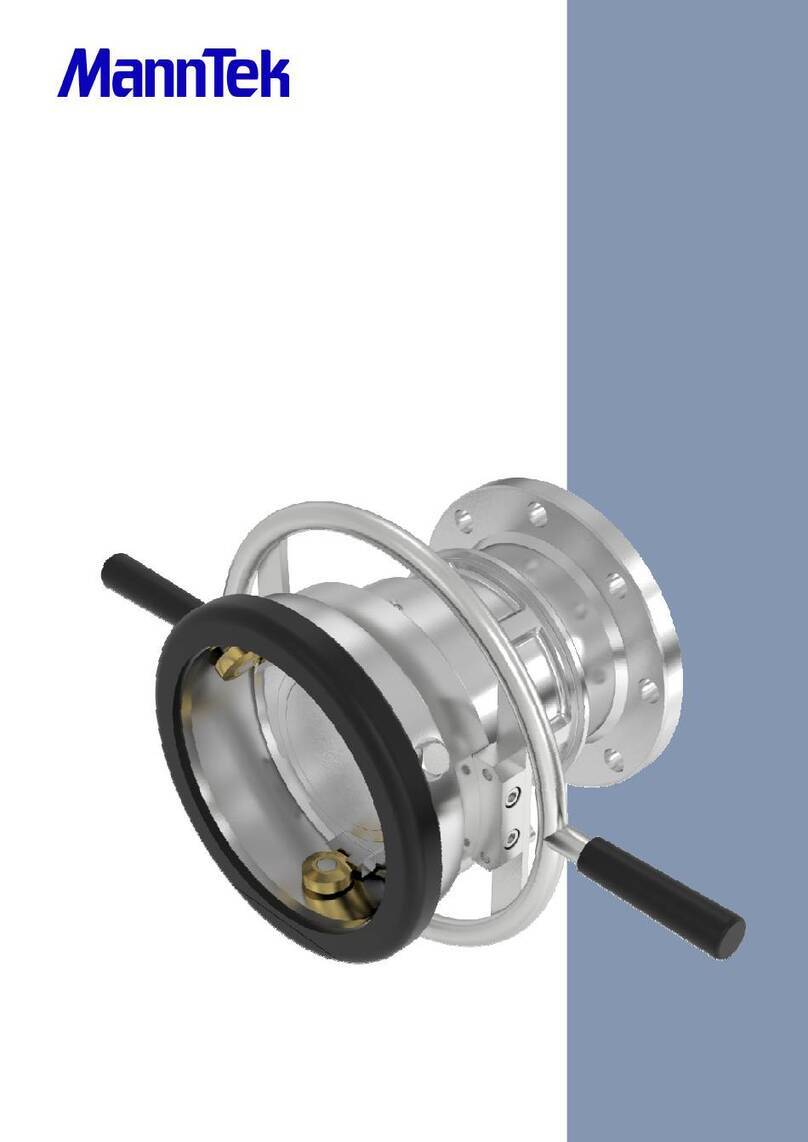
Manntek
Manntek DDC Original operating manual
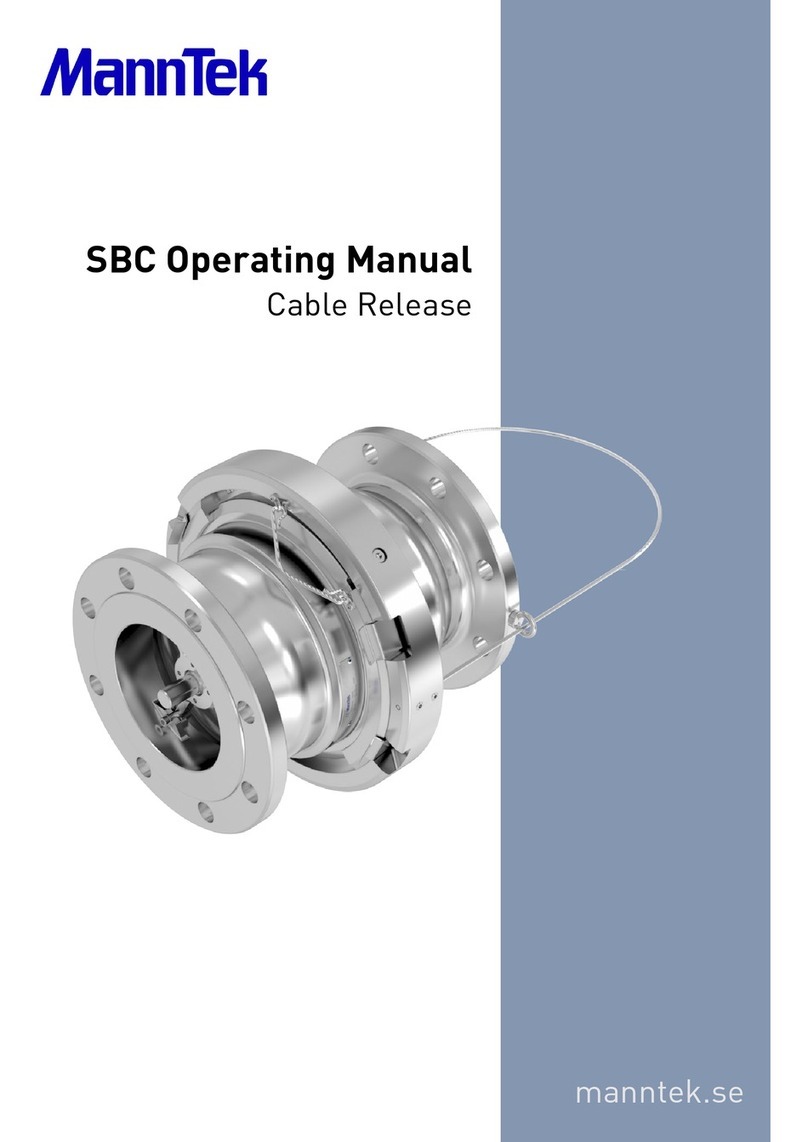
Manntek
Manntek SBC User manual
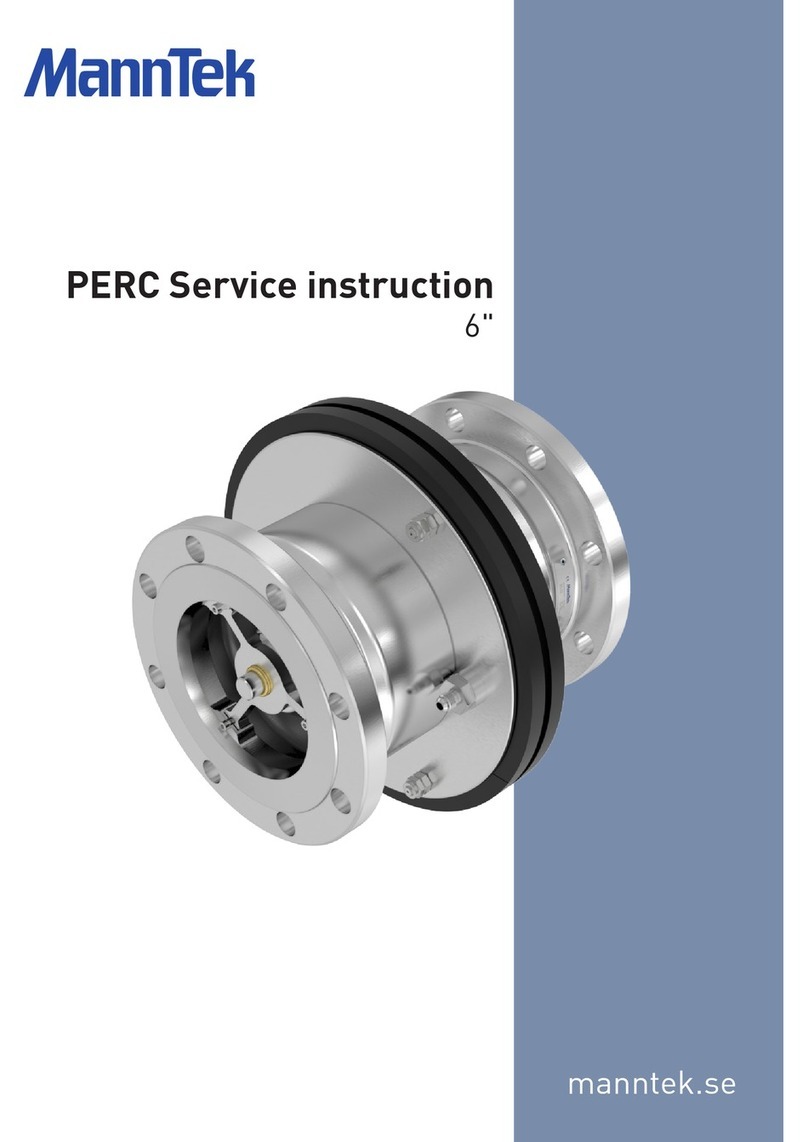
Manntek
Manntek PERC Original operating manual
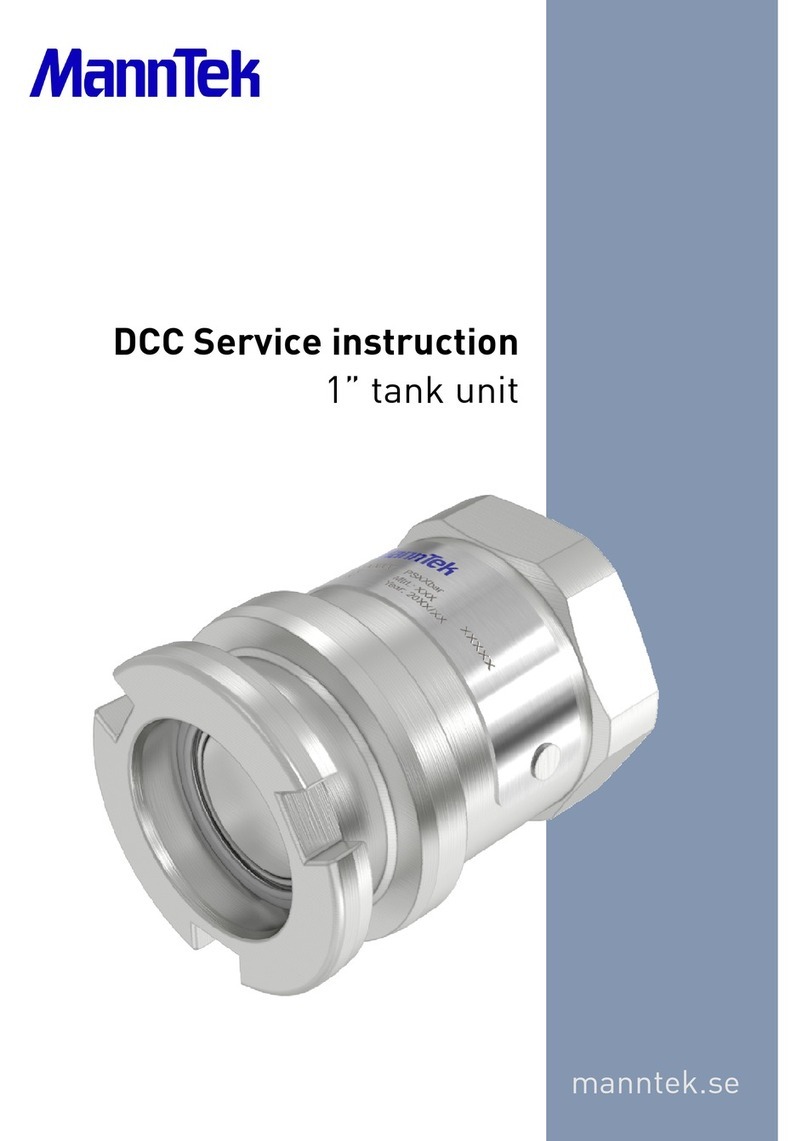
Manntek
Manntek DCC Original operating manual
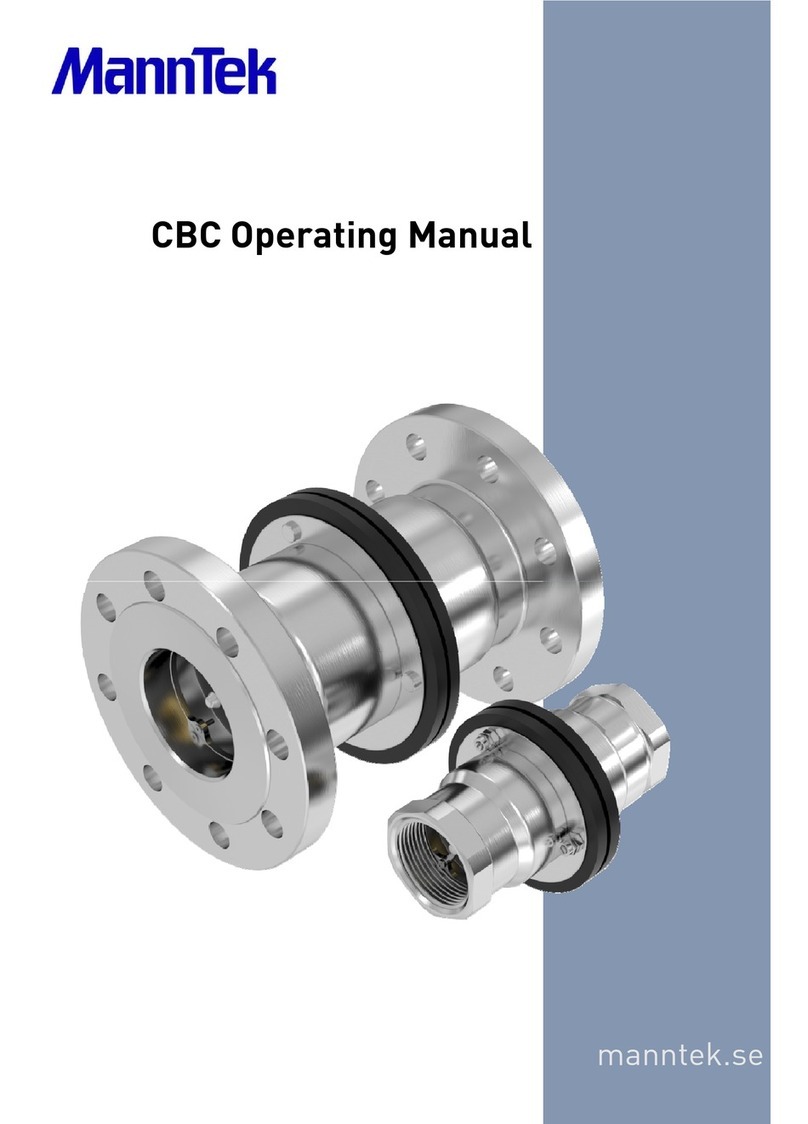
Manntek
Manntek CBC User manual

Manntek
Manntek SBC Original operating manual

Manntek
Manntek DDC Original operating manual

Manntek
Manntek DCC Original operating manual

Manntek
Manntek SBC Original operating manual
